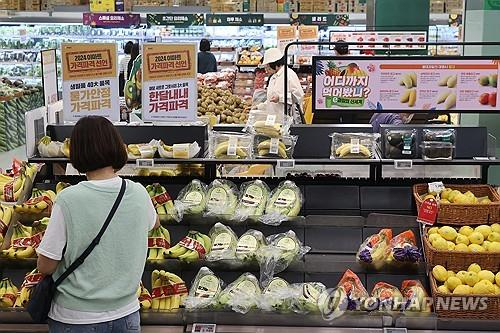Customers checking fruits at a major discount chain store in Seoul. [YONHAP]
Korea’s household income rose 1.4 percent on year in the first quarter of 2024, but the inflation-adjusted figure fell by the largest margin in seven years amid high prices and falling wages, data showed Thursday.
The average income per household came to 5.12 million won ($3,748) per month in the January-March period, compared to 5.05 million won tallied a year earlier, according to the data from Statistics Korea.
When adjusted for inflation, however, the income fell 1.6 percent on year, which marked the sharpest fall since the first quarter of 2017, when the figure logged a 2.5 percent decline.
Income earned through wages shed 1.1 percent on year to an average of 3.29 million won per month, as major companies slashed incentives and other benefits amid poor performances last year.
The inflation-adjusted income through wages sank 3.9 percent, the largest fall since 2006, when the agency began compiling the relevant data.
But the monthly average income from business operations added 8.9 percent to 875,000 won, and transfer income backed by state support climbed 5.8 percent to 818,000 won in the first quarter.
Monthly household spending rose 3 percent on year to 2.91 million won in the first quarter, as people spent more on food and nonalcoholic beverages, dining out, accommodation and entertainment amid high inflation.
The monthly disposable income per household grew 1.4 percent to 4.05 million won.
Households’ average propensity to consume, measured by the percentage of consumption expenditures out of disposable income, rose 1.2 percentage points on year to 71.9 percent in the first quarter, the data showed.
The distribution ratio for disposable income, a key barometer of earnings equality, narrowed in the first quarter on falling income by the top 20 percent group.
The average monthly income of the bottom 20 percent income bracket advanced 11.2 percent on year to 1.16 million won.
But people of the upper 20 percent group earned an average of 11.26 million won per month, down 2 percent from a year earlier.
The distribution ratio came to 5.98 in the first quarter, which means that the top 20 percent income bracket had 5.98 times more earnings than those in the bottom 20 percent over the cited period.
The first quarter figure logged a decrease from 6.45 tallied a year earlier. A higher ratio means a wider inequality in income distribution.
Yonhap

